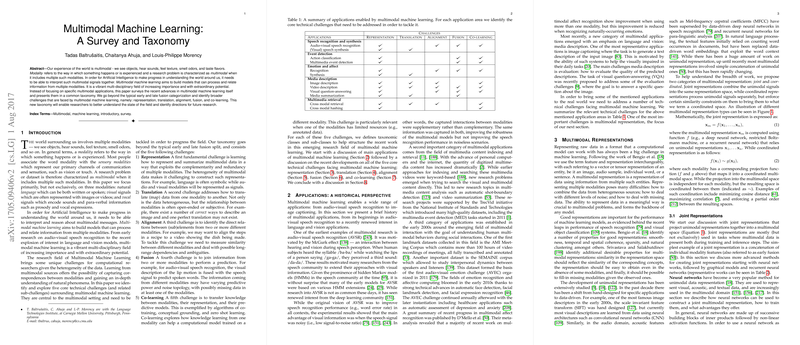Multimodal Machine Learning: A Survey and Taxonomy
The paper "Multimodal Machine Learning: A Survey and Taxonomy" by Tadas Baltrušaitis, Chaitanya Ahuja, and Louis-Philippe Morency presents a comprehensive survey of the field of multimodal machine learning (MML) and introduces a novel taxonomy that organizes the core challenges in the domain. The authors contend that understanding and integrating multiple modalities—such as visual, textual, and auditory information—is crucial for the advancement of artificial intelligence systems.
Key Challenges in Multimodal Machine Learning
The taxonomy proposed in the paper breaks down the multimodal machine learning challenges into five primary areas: representation, translation, alignment, fusion, and co-learning.
- Representation:
- The goal is to develop approaches to represent and summarize multimodal data. The heterogeneity in data types makes it difficult to construct representations that exploit the complementarity and redundancy of multiple modalities. The authors categorize representation into joint and coordinated representations. Joint representations create a unified space for multiple modalities using methods like deep networks and graphical models. Coordinated representations maintain separate unimodal representations but constrain their similarity through mechanisms like canonical correlation analysis (CCA).
- Translation:
- This involves the mapping from one modality to another (e.g., from images to text). Approaches are split into example-based and generative models. Example-based methods are further divided into retrieval and combination-based, while generative models include grammar-based, encoder-decoder models, and continuous generation models. The authors provide detailed insights into recent successful applications ranging from image captioning to speech synthesis. They highlight that while generative models have shown remarkable progress, evaluation remains a significant hurdle.
- Alignment:
- Alignment aims to find correspondences between sub-components of instances across different modalities. There are explicit alignment models, which directly tackle the alignment problem using supervised or unsupervised learning, and implicit alignment models, which align inputs as a latent intermediate step. Neural attention mechanisms are commonly used in implicit alignment, performing well in tasks requiring temporal or spatial alignment.
- Fusion:
- Multimodal fusion integrates information from different modalities to predict an outcome measure. The survey identifies model-agnostic fusion approaches (early, late, and hybrid fusion) and model-based approaches including multiple kernel learning (MKL), graphical models, and neural networks. Each method has its own strengths and is often chosen based on the specific application requirements.
- Co-learning:
- Co-learning involves enhancing one modality by leveraging information from another modality. This is particularly useful when one modality has limited available resources. The paper defines parallel data approaches, non-parallel data approaches, and hybrid data approaches. For instance, co-training exploits labeled data in one modality to improve performance in another. Transfer learning and zero-shot learning are highlighted as effective co-learning strategies, especially in scenarios where annotated data is scarce.
Implications and Future Directions
The authors' taxonomy provides a structured framework that enables researchers to categorize existing work and identify research gaps. The thorough exploration of each challenge along with the state-of-the-art methodologies creates a resource that can guide the development of future multimodal systems. The authors note several key implications and potential future directions:
- Evaluation Metrics: Current metrics for translating and generating multimodal data (such as BLEU for text) are limited, and the field would benefit from the development of more reliable evaluation techniques that correlate well with human judgment.
- Scalability and Real-world Application: The requirement for large annotated datasets remains a bottleneck. Research efforts should focus on methods that reduce the dependence on extensive labeled data, such as self-supervised and unsupervised learning techniques.
- Integration with New Modalities: Emerging modalities, including haptic feedback and molecular data, present new opportunities and challenges. Developing methods to integrate these novel data types will be important for broadening the applicability of MML.
- Interpretable Models: As neural networks dominate the field, there is a growing need for models that provide interpretability to enhance trust and facilitate debugging. Incorporating explicit alignment and rationales for decision-making can contribute to more transparent MML systems.
- Cross-disciplinary Applications: While the focus traditionally has been on audiovisual data, the methodologies and taxonomies outlined can be extended to applications in healthcare, robotics, and other fields where multimodal data is prevalent.
In conclusion, this paper makes significant contributions by providing a detailed taxonomy of challenges in multimodal machine learning, survey current methodologies, and suggesting directions for future research. As the field evolves, the insights from this survey will remain valuable for guiding ongoing and future work in MML.
